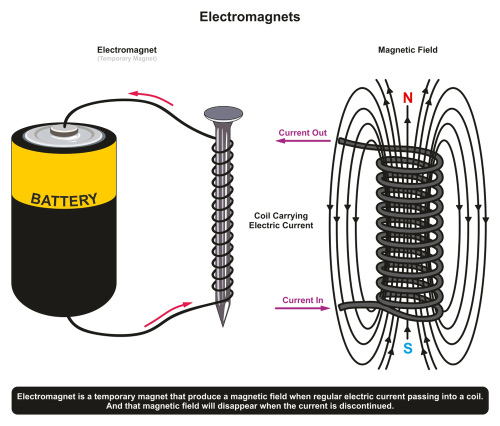We'll be back in a bit !
The system is currently undergoing a routine upgrade to ensure you get the best learning experience. The maintenance is expected to continue till 8:00 pm. Please check back later.
Thank you for your understanding!

Magnets in general can be classified into permanent and electromagnets. Permanent magnets are found naturally in the form of minerals known as magnetite. They are created owing to the intrinsic gravitational, electrical, and magnetic effects of the Earth.
On the other hand, electromagnets get magnetized only when an electric current is passed through them.
Magnets possess two ends, which are known as the north and south poles.
When the same poles of two different magnets are brought together, they repel.
Similarly, unlike poles, two magnets attract each other.
A single pole can never exist and cutting the magnet into two only leads to two smaller magnets, each consisting of two poles.
Electromagnets only work as magnets as long as a current is passing through them.
We can create artificial permanent magnets using special processes.
The magnetic field created by any magnet always points from the south to the north pole inside the magnet, and in the reverse direction otherwise.
For a piece of wire carrying a current, if we align the thumb of our right hand along the direction of the current, our fingers curl in the direction of the magnetic field. This law is universally valid.
Freely suspended magnets align themselves along the north-south direction.
Electromagnets exist owing to the intrinsic relationship between electricity and magnetism. Their characteristics can be understood by using a few laws that physicists have proposed over the years. Electromagnets are generally created by wrapping a coil of wire around a piece of iron or other ferrous materials. When current is passed through this coil, it gets magnetized. As long as current keeps passing through the wire, electromagnets act just like natural magnets. The figure below shows the construction of an electromagnet:
The intensity of the magnetic field created by an electromagnet depends primarily on the amount of current passing through it.
Common uses of electromagnets are encountered in electric generators, AC transformers, and induction cooktops.
For creating electromagnets, the material used must have high magnetic permeability, and low retentivity, and thus, its hysteresis curve must be narrow.
Electromagnets remain magnetized only as long the current keeps passing through them.
The magnetic fields by a bar magnet and a circular current loop are shown below. They may be observed in practice by placing a piece of paper above the magnet and placing iron fillings on it.
All magnetic materials can be classified into diamagnetic, paramagnetic, and ferromagnetic materials. Their properties can be understood by their behavior in an external magnetic field.
Diamagnetic materials resist external magnetic fields and do not get magnetized. Their electrons align themselves in a way so that the magnetic field lines are expelled from the material. Gold and silver are two common examples.
Paramagnetic materials can get temporarily magnetized in an external magnetic field. They have unpaired electrons inside their atoms and thus, can get weakly magnetized as long as an external magnetic field is present. Magnesium and lithium are two examples of such types of materials.
Ferromagnetic materials can be permanently magnetized using an external magnetic field and make good, strong magnets since they have a large number of unpaired electrons.
This tutorial provided insight into the concept of magnetism and electromagnets. Further, we got to understand diamagnetic, paramagnetic, and ferromagnetic materials. We also looked at properties that are universal across magnets and a few properties that are exclusive to electromagnets.
1. How are Maxwell's equations connected with electromagnetism?
Maxwell’s equations relate electric and magnetic fields together and form the basis of electrodynamics. They are four in number:
Gauss’s law: This law relates the electric field to the charge enclosed by a surface.
Non-existence of magnetic monopoles: This law physically means that magnetic monopoles can never exist.
Faraday’s law: This law relates the induction of electric fields with a time–varying magnetic field.
Ampere-Maxwell law: This law relates the induction of magnetic fields owing to a time-varying electric field.
2. What is the principle behind a transformer?
Transformers are based on the concepts behind magnetic induction, which are mathematically described by Faraday’s law. It states that a changing magnetic flux leads to the induction of an electromotive force in a circuit.
3. What are the ways to increase the magnetic strength of an electromagnet?
The strength of an electromagnet depends primarily on the current flowing through it. Thus, we can either increase the current, increase the number of turns if we are using a coil, or use specific types of materials as the core of the coil.
4. Does the Earth have an intrinsic magnetic field?
Yes. Since there are a large number of ions flowing through the magma of Earth, they give rise to a weak magnetic field. This is also the reason why magnets suspended freely align themselves in a particular direction. The magnetic field intensity of Earth is only about 0.25 to 0.65 Gauss.
5. Explain an application of electromagnetism in the medical field.
MRI scans allow us to diagnose various diseases. MRI scans utilize very large electromagnets to generate an image of the inside of the human body. This is why it is very dangerous to go into the MRI room with something magnetic in your pocket.
